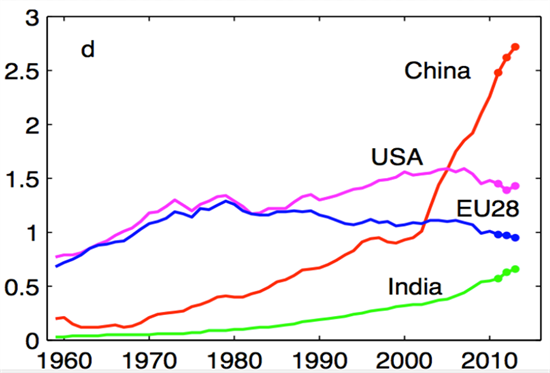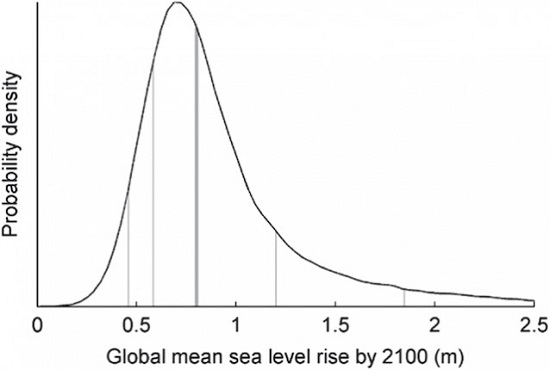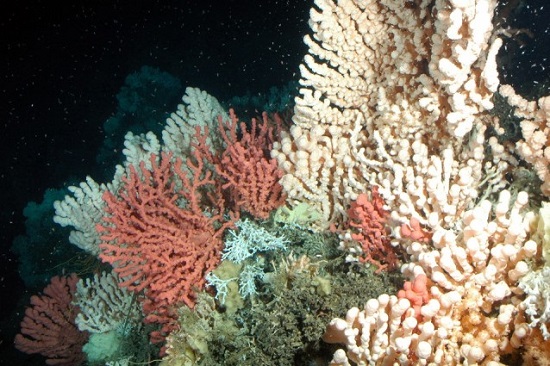1. 25 climate change disasters
Business Insider, Australia tells us that 25 disasters may befall us from climate change. The assumptions are conservative – 2°C and half a metre of sea level rise by 2100, though the text sometimes specifies more. Some of the predictions are disturbing:
- By 2050 200 million people could be displaced by environmental changes. With a 3°C temperature rise, sea levels could displace 600 million, albeit over 2000 years.
- All coral reefs could disappear by 2050.
- The marine food chain could fall apart.
- 63% of major wine regions will no longer be suitable for grape-growing by 2050.
- Some reptile species could turn mostly female, potentially leading to their extinction. Species affected include turtles, alligators, crocodiles, and some lizards.
- Equatorial regions and parts of the Antarctic will see up to a 50% decrease in their fisheries. That’s without ocean acidification and overfishing.
- Climate change may lead to more depression and anxiety.
And so on.
It’s interesting that the article was published in a business journal.
2. Fugitive emissions of methane are far, far greater than expected
In the United States the EPA does not measure the fugitive emissions of methane produced during shale gas drilling – it simply accepts the company estimates. A number of attempts have now been made to monitor actual emissions. The results are alarming.
In one study, for example, seven natural gas well pads being drilled in southwest Pennsylvania were spewing methane up to 1,000 times the EPA estimate.
The question raised by these studies is whether shale gas has any advantage at all over coal in greenhouse terms.
3. How much do China’s exports contribute to emissions
You may recall this dynamic surge in China’s CO2 emissions:

The question arises as to how much China emits is related to its own consumption and how much relates to exports to other countries. Carbon Brief calculates that in 2012 only 16% related to exports:

If you take out the export factor this is how per capita emissions stack up for the major emitters:

4. New CCS technology
A form of slurry is proposed to capture carbon in power stations. It’s at the proof of principle stage, so it’s early days in developing the technology. The problem of where to stow the stuff remains unchanged. Meanwhile:
on Thursday Canada fired up the world’s first commercial-scale coal-fired power plant equipped with CCS technology. The $1.3 billion plant, operated by Saskatchewan’s provincial power provider, is slated to cut its CO2 emissions by 90 percent compared to a comparable coal-fired power plant and will sell its captured CO2 to the oil and gas industry.
5. Pay attention to maximum sea level rise forecasts
The IPCC AR5 report had difficulty in nominating a maximum sea level rise because of uncertainty over ice sheet decay. A new study decided to ask 13 ice sheet experts for their opinion. They came up with a likely rise of 80 cm and a worst case (5% probability) of 180 cm, significantly higher than IPCC AR5:

There are several problems with this.
Firstly, the experts were asked in January 2013. Several studies this year indicated that both Antarctica and Greenland were less stable than thought.
Secondly, there is a fat tail on the upside. Costs do not increase in a linear fashion. For example, from the study itself:
The annual damage costs for the European Union with sea level rise of 1.4 m by 2100 are projected to be six times greater than for the rise of 0.6 m
The risks at the upper level are so great that no cost of mitigation is too high to justify.
Thirdly, our focus should be on a lot longer than 100 years. A study by Lambeck et al looked at the last 35,000 years. Coming out of the last ice age, the ice melted from 16,000 to 8,000 years ago. Sea level rise continued a further 2,000 years after that, making a total span of 10,000 years.
The only sensible mitigation strategy is to get emissions down to 350 ppm or less.
6. The other CO2 problem: ocean acidification
“The reef is safe!”
Thus spake the premier of this fair state on the box earlier tonight. I’m always disappointed that protests from green groups only worry about things like farm runoff and dumping sludge. They never address what could destroy the reefs utterly – ocean acidification, or more correctly, oceans becoming less alkaline.
See Item 1 above, which suggested coral reefs could be gone by 2050.
A new UN report says the costs of acidification are difficult to establish but could amount to $1 trillion by 2100. That’s for “services like coastline maintenance”, and doesn’t include “effects on tourism or other industries.”
Again the longer term is a huge worry. Back in the Paleocene-Eocene Thermal Maximum (PETM) about 56 million years ago we released 2,000 to 3,000 petagrams of carbon into earth’s atmosphere over 10,000 years. Ocean acidification levels took 100,000 years to recover. We look like releasing 5,000 petagrams over 500 years.
Here’s some lovely Norwegian coral to enjoy while we can.

7. Coal’s contribution
Queenslanders think the coal industry employs 13% of the workforce. In fact it employs 1.2%. More Queenslanders work in the Arts and Recreation sector than in the coal industry.
And the contribution to the state budget is about 4%, the same as motor vehicle registrations.


I found myself musing over the kind of human that is likely to survive the coming anthropocene extinction.
The early casualties are going to be women who need assisted births in the west along with most large bonded people, and medication dependent people. Women who want to survive will be partnering shorter smaller men. It will be a very difficult adjustment to return to a non contraceptive way of living. There are probably enough clothes in the world to last a hundred years with the sharp reduction in population that will occur before alternatives will need to be found, but clothing manufacture might be one industry that will be maintained at a modest level. There are likely to be enough solar panels in most continents to maintain a useful degree of basic industry.
The survivability zone will be Canada in the Americas and northern Europe and Russia. That means a massive relocation of peoples of many ethnicities, which considering how many weapons there are in the world, will not be a good time in human history.
..large boned..
As a rough approximation, the volume taken up by a gas is about the same per molecule. This means that if you extract a molecule of methane (CH4) from the ground and burn it. The result will be one molecule of CO2 which will take up the same amount of underground space as the original molecule of methane.
The sums get worse if we are talking about something like natural gas. Burning one molecule ethane, propane etc. will generate two or more molecules of CO2. In other words the extraction of natural gas does not leave enough space for the CO2 generated when it burns. (OK, the above is for perfect gases and it may be possible to store more CO2 under some circumstances.such as using higher storage pressures or operating at pressure/temp combination that would store CO2 as a liquid.
Bottom line: CCS is not going to save fossil power stations from cheap renewables and may not be able tosave things like the steel industry.
Some industries, John D, will continue regardless of their emissions as they are essential for adaptation to destructive climate change. The steel industry and the cement industries will be two of those. There are significant efforts being made to reduce their CO2 footprints, but the backbone of our survival is shelter, some things we need no matter what. In a more strategically organised world you would have an algal oil facility beside a cement mill to utilise the CO2 for fuel production, but that is not going to happen anytime soon unless Shell Oil or Boeing decide to do it.
Bilb: Even with existing technology we can get very close to zero emissions. However, agree that we proceed in a logical progression by generally starting with things that have the lowest cost per tonne CO2 abatement.
Big battery news.
http://blog.cafefoundation.org/ornl-makes-two-two/
Coal’s Contribution? 1.2%? What a joke. There’ll be a lot fewer than 1.2% Queenslanders working in coal mining because they will be replaced by even more 457 visa holders.
Look, I’m calling BS on this due to China Steel results but I’ll put it up anyway coz Brian likes this sort of thing.
World’s Most Responsible Construction Companies Unveiled
Thanks, BilB @ 6 and jumpy for the links.
jumpy, it’s hard to know. How do you judge “engagement and responsiveness to stakeholder concerns”?
Still, the exercise will be of interest to ethical investors.